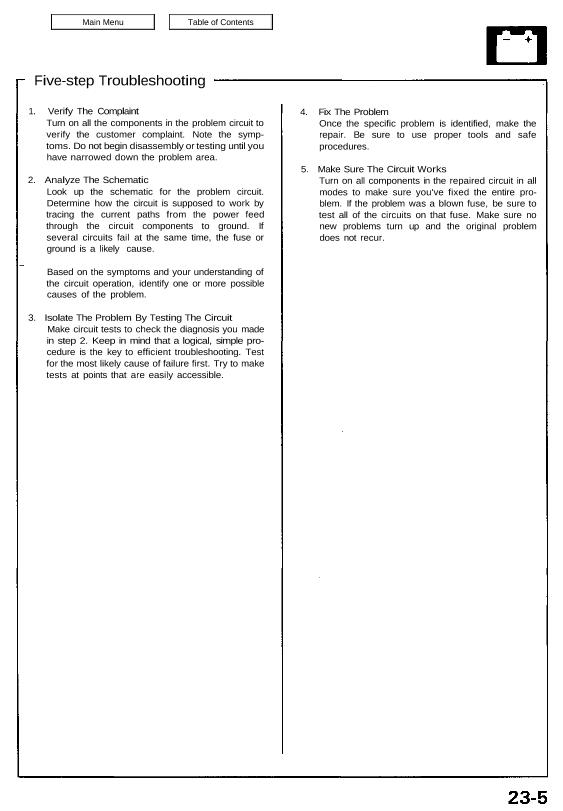Five-step Troubleshooting
1. Verify The Complaint
Turn on all the components in the problem circuit to
verify the customer complaint. Note the symp-
toms. Do not begin disassembly or testing until you
have narrowed down the problem area.
2. Analyze The Schematic
Look up the schematic for the problem circuit.
Determine how the circuit is supposed to work by
tracing the current paths from the power feed
through the circuit components to ground. If
several circuits fail at the same time, the fuse or
ground is a likely cause.
Based on the symptoms and your understanding of
the circuit operation, identify one or more possible
causes of the problem.
3. Isolate The Problem By Testing The Circuit
Make circuit tests to check the diagnosis you made
in step 2. Keep in mind that a logical, simple pro-
cedure is the key to efficient troubleshooting. Test
for the most likely cause of failure first. Try to make
tests at points that are easily accessible.
4. Fix The Problem
Once the specific problem is identified, make the
repair. Be sure to use proper tools and safe
procedures.
5. Make Sure The Circuit Works
Turn on all components in the repaired circuit in all
modes to make sure you’ve fixed the entire pro-
blem. If the problem was a blown fuse, be sure to
test all of the circuits on that fuse. Make sure no
new problems turn up and the original problem
does not recur.
1. Verify The Complaint
Turn on all the components in the problem circuit to
verify the customer complaint. Note the symp-
toms. Do not begin disassembly or testing until you
have narrowed down the problem area.
2. Analyze The Schematic
Look up the schematic for the problem circuit.
Determine how the circuit is supposed to work by
tracing the current paths from the power feed
through the circuit components to ground. If
several circuits fail at the same time, the fuse or
ground is a likely cause.
Based on the symptoms and your understanding of
the circuit operation, identify one or more possible
causes of the problem.
3. Isolate The Problem By Testing The Circuit
Make circuit tests to check the diagnosis you made
in step 2. Keep in mind that a logical, simple pro-
cedure is the key to efficient troubleshooting. Test
for the most likely cause of failure first. Try to make
tests at points that are easily accessible.
4. Fix The Problem
Once the specific problem is identified, make the
repair. Be sure to use proper tools and safe
procedures.
5. Make Sure The Circuit Works
Turn on all components in the repaired circuit in all
modes to make sure you’ve fixed the entire pro-
blem. If the problem was a blown fuse, be sure to
test all of the circuits on that fuse. Make sure no
new problems turn up and the original problem
does not recur.
